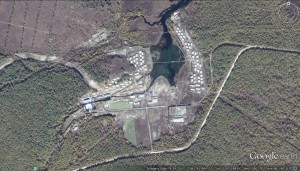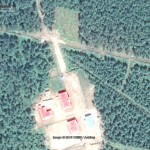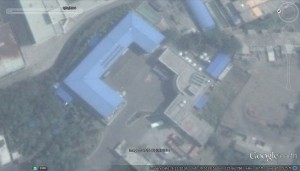UPDATE 3 (2015-8-4): US group seeks seizure of Mudubong. According to the Financial Times:
The family of a South Korean man believed killed in North Korea are trying to seize a Pyongyang-owned vessel being held in Mexico, in a new sign of how legal snares are complicating the regime’s international trade.
Kim Dong-sik, a 53-year-old pastor, was abducted by North Korean agents in China in 2000 and can be presumed dead, a US court ruled in April. It ruled that Pyongyang should pay $330m to Mr Kim’s family, who are US citizens.
The family have seen an opportunity to secure a first instalment of this sum, in the form of the Mudubong, a North Korean cargo ship held by Mexican authorities since colliding with a coral reef last July.
On Tuesday their lawyers vowed to appeal after a Mexican court declined to consider their petition to place a lien on the Mudubong, which would give them the legal right to seize it. The court ruled on Monday that the case did not fall under its jurisdiction.
“We want to get the boat into our hands and sell it, and put the money towards the judgment against North Korea,” said Nitsana Darshan-Leitner, the family’s lead lawyer, who represented the family in the successful US action and who has previously won cases resulting in the seizure of Iranian-owned assets in the US.
Some legal experts consider the move a long shot, given that the US ruling would first have to be recognised in Mexico — an opinion seemingly endorsed by the Mexican court’s initial ruling. However, Alberto Mansur, the lawyer representing the family in Mexico, maintains that the case is on firm ground.
“This has never been done when the defendant is a sovereign nation but the recognition procedure is pretty straightforward,” he said.
The North Korean embassy would be the defendant in the case, he said. “Our laws provide for the attachment of assets when enforcing a claim,” Mr Mansur added.
The lawsuit brings a new twist in an affair that reflects the complexity of efforts to implement UN sanctions against Pyongyang. Two weeks after the Mudubong ran aground off the Mexican coast, the UN Security Council and US Treasury issued new sanctions against Ocean Maritime Management, which was accused of involvement in illicit arms trading. OMM is the Mudubong’s ultimate owner, according to a panel of experts appointed by the Security Council.
In an attempt to sidestep this measure, the panel of experts reported in February, North Korea has attempted to conceal the fact that OMM controls Mudubong. The registered owner, Mudubong Shipping Company, was quoted by North Korean media in May as saying: “Our company is a corporate body independent of [OMM] . . . There is . . . neither reason nor ground . . . to make the ship subject to ‘sanctions’.”
But the experts’ report said they still considered the Mudubong an asset of OMM, and had conveyed this to Mexico’s government. The report criticised weak implementation of sanctions against OMM, with at least six nations inspecting OMM vessels but failing to impound the ships.
“The Security Council confirmed on May 6 the Mexican government’s obligation to continue freezing the Mudubong. Mexico will continue to abide by this decision for as long as it is not modified or withdrawn by the Security Council,” the Mexican foreign ministry said in an emailed response to questions.
The ministry did not respond to a question about what it planned to do with the ship.
UPDATE 2 (2015-7-17): Mexico has repatriated the remainder of the crew. According to UPI:
All 33 North Koreans on board a ship that had drifted into a coral reef near Mexico have been repatriated after a year of custody.
Mexico media outlet E-veracruz reported Friday a port operations manager in Tuxpan, Veracruz said 13 remaining North Koreans were sent home on Wednesday.
33 North Korean nationals were on board the Mu Du Bong when the ship had fallen off its designated sea route, and 20 detainees were released earlier this year, South Korean news agency Yonhap reported.
Two members of the North Korean embassy in Mexico had visited the port city to urge the release of the remaining 13 on Tuesday.
The 6,700-ton Mu Du Bong had left from a Cuban port in July 2014 before it was stranded on the reef 9 miles from Tuxpan.
Mexico had detained the ship’s personnel because the two countries were in disagreement over the ownership of the Mu Du Bong.
Mexico had said the ship belonged to North Korea’s Ocean Maritime Management, a firm blacklisted by the U.N.’s North Korea sanctions committee for engaging in illicit arms trades in the past.
In response, North Korea’s top envoy to the U.N. denied any links between the Mu Du Bong and the blacklisted company.
Read the full story here:
Mexico repatriates all 33 North Koreans on board ship Mu Du Bong
UPI
Elizabeth Shim
2015-7-17
UPDATE 1 (2015-5-9): DPRK unhappy with UN freeze on Mudubong. According to Xinhua:
The Democratic People’s Republic of Korea (DPRK) slammed the United Nations Security Council on Friday for slapping sanctions on “Mudubong,” a DPRK’s cargo ship that has been held for almost ten months in Mexico after it struck a coral reef off the coast.
The UN Security Council decided to freeze the Mudubong ship on Wednesday because it believed the ship belongs to Ocean Maritime Management (OMM) Co., Ltd, a company blacklisted by the United Nations in July 2014 for shipping embargoed arms.
But the manager of Mudubong Shipping Co., Ltd., whose name was not given, claimed that Mudubong is a legitimate commercial ship operated by Mudubong Shipping Company and has no links to the OMM, according to the KCNA news agency.
“Our company is a corporate body independent of the Ocean Maritime Management Co., Ltd. as it is a social cooperative organization established according to relevant laws of the DPRK,” the manager said in a statement.
“I vehemently denounce the step as a provocation of the hostile forces to lay a hurdle in our shipping business, a wanton breach of international law, undisguised disregard of domestic laws of the sovereign state and … a grave encroachment on the sovereignty of the DPRK,” the KCNA quoted the manager as saying.
The manager insisted Mudubong is “a peaceable civilian trading ship which has neither violated international law nor handled any prohibited cargo,” adding that the Security Council has no justification to impose the sanctions.
The manager requested Mexican authorities to provide cooperation on the principle of humanitarianism in letting free the ship together with its crew members.
Read the full story here:
DPRK slams UN freeze on Mudubong cargo ship
Xinhua
2015-5-9
ORIGINAL POST (2015-4-23): McClatchy post solid summary of Mudubong case:
The cargo holds were empty and the 430-foot-long North Korean freighter Mu Du Bong was riding high in the water when the vessel slammed into a coral reef in Mexican waters in the Gulf of Mexico last July 14, thudding to a halt.
The freighter did more than tear up staghorn and elkhorn coral. It also crashed into U.N. sanctions that have trapped it in the hands of the Mexican government.
Salvage vessels pulled the freighter off the reef 12 days later and brought it to port in Tuxpan, where it’s been idle for nine months, moored to a wharf on the Tuxpan River. North Korea has declined to repatriate the 33 crew members, and they occasionally can be seen fishing off the freighter’s deck.
Earlier this month, North Korea’s deputy representative to the United Nations made some slightly menacing remarks demanding that Mexico terminate what he called a “complete abnormal situation.”
“We will take necessary measures to make the ship leave immediately,” envoy An Myong Hun said at a news conference April 8 in New York.
It’s an odd standoff in a corner of the world far from North Korea and the chambers of the U.N., where diplomats knowingly mention 1718, 1874 and 2094, the Security Council resolutions aimed at shutting down North Korea’s nuclear program and reining in its weapons proliferation efforts.
It was those arms-trafficking practices that led the U.N. Security Council to impose sanctions on a North Korean concern, Ocean Maritime Management Co. Ltd., that counts the Mu Du Bong among its 14 oceangoing freighters.
Another of the company’s vessels was intercepted in Panama nearly two years ago, its cargo holds piled high with sacks of Cuban sugar. When inspectors removed the sacks, they discovered two MiG-21 fighter jets, 15 jet engines and radar control systems for missile launches. The freighter, the Chong Chon Gang, had left Cuba bound for North Korea and was about to transit the Panama Canal when Panamanian inspectors boarded it. Cuba claimed the war materiel was being sent to North Korea to be refurbished and was to be returned.
The harbormaster at the Port of Tuxpan, Alberto Orozco Peredo, said the captain of the Mu Du Bong had a far humbler mission than smuggling weaponry.
“He was coming for fertilizer,” Orozco said, adding that the freighter had been chartered in Cuba for a single excursion to Tuxpan to pick up the shipment and return to the island. “Maybe they (the North Koreans) offered to do the shipping for cheap.”
Orozco said he’d accompanied members of a U.N. Security Council sanctions committee when they inspected the moored ship. He said they’d found nothing.
“For a 30-year-old ship, it was in a good state of repair. You can see that it’s clean,” Orozco said. “The vessel complies with all security standards.”
The crew members have shore passes but rarely leave the vessel. When six months had passed, their temporary visas expired. In recent days, immigration officials have begun the work of granting them indefinite humanitarian visas.
While North Korea can’t dislodge its ship, the reason it keeps all the crew members in Mexico is unclear.
“From day one, they have been free to move wherever they want to go, within or outside Mexico,” Ricardo Alday, political coordinator of Mexico’s mission to the U.N., said in an email.
A local shipping agency, Tajin Consignaciones, arranges through the North Korean embassy in Mexico City to provide food to the crew. Agency director María de los Ángeles Monsivais declined to speak to a reporter.
The U.N. Security Council hit Ocean Maritime Management with sanctions last July, and the company scrambled to keep its ships on the high seas without seizure, often with their maritime transponders turned off.
“Thus far, 13 of the 14 vessels controlled by OMM have been renamed, their ownership transferred to other single ship-owner companies . . . and vessel management transferred to two main companies,” said a preliminary U.N. report dated Feb. 23.
The freezing of the Mu Du Bong has put Mexico in a tough position.
“There is no set procedure for what to do once they seize the ship,” said Jeffrey Lewis, director of the East Asia Non-Proliferation Program at the Center for Nonproliferation Studies, part of the Monterey Institute of International Studies in California.
Some experts think that going after North Korean freighters engaged in ordinary trade is only likely to drive Pyongyang away from any negotiations.
“That’s a misguided effort. People have to make a distinction between things that are prohibited and normal commercial activity,” said John Merrill, a former chief of the Northeast Asia division of the State Department’s Bureau of Intelligence and Research. “It seems a little bit ridiculous to keep holding these guys, and it’s going to have consequences.”
Others disagree, saying economic pressure on North Korea is the only way to get its attention and force concessions.
“The purpose of the sanctions is to buy time for diplomacy. If the sanctions are not being enforced, then there’s no pressure at all on North Korea,” said William J. Newcomb, a visiting scholar at the School of Advanced International Studies at Johns Hopkins University who’s a former member of the U.N. Security Council’s panel of experts on North Korea sanctions.
Newcomb noted that the Mu Du Bong’s travels were similar to the activities of the Chong Chon Gang before it was caught carrying Cuban weapons.
“It had all the earmarks of an arms transfer,” he said.
Mexico reportedly was about to free the ship late last year, but An, the North Korean envoy, said the nation had received a warning from a senior U.N. official.
“Suddenly, the Mexico government revoked its position. They said they have received advice from an unnamed undersecretary-general of the United Nations for the continued detention of the ship,” An told reporters.
Now, Mexico’s posture is that the ship will be retained indefinitely.
“The ship will be held (as long as) the company that owns it remains under U.N. sanctions,” Alday wrote in his statement, noting that Mexico “is obliged to comply with U.N. Security Council resolutions.”
A former senior Mexican diplomat, Andrés Rozental, said Mexico wasn’t worried about any possible retaliation from North Korea.
“They’re obviously not going to send their military here to free that boat,” he said.




